Automate Amazon Ads: A Complete Guide to Maximizing Sales
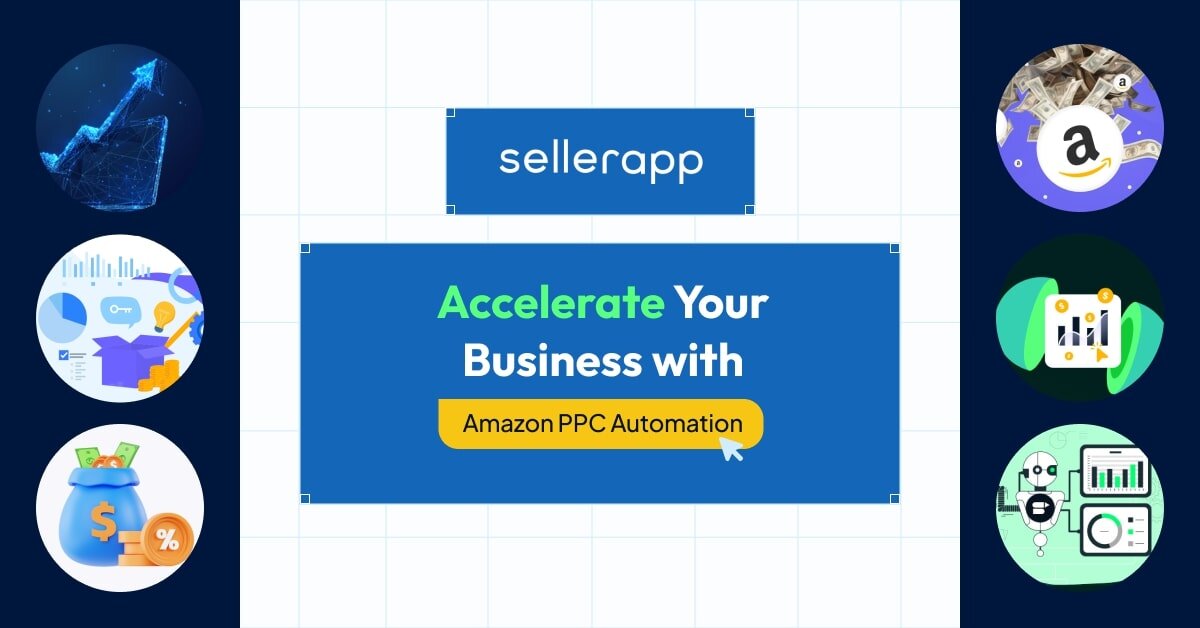
Running Amazon PPC ads is absolutely important if you want to succeed as a seller on the popular marketplace. However, without an Amazon PPC Automation tool, sellers can find it incredibly challenging to effectively monitor bids, keywords, and performance across several products. It can quickly turn into a full-time job and even become overwhelming if you have to manage several hundred campaigns.
Moreover, even if you don’t want to use an automation tool, you’re competition will and they will use it to steal a massive portion of the market share. Therefore, Amazon PPC automation tools are essential. Especially if you’re a mid-market or enterprise-level seller. As completion intensifies on the Amazon marketplace, those that rely solely on manual processes risk losing visibility and sales to more agile competitors.
By leveraging advanced Amazon automation tools such as SellerApp, you can streamline your overall PPC, efficiently optimize campaigns, and drastically minimize any human errors.
However, not all automation tools are built the same way and it’s important to note that building an Amazon business with automation tools requires a strategic approach.
Well, we’ve consolidated the best practices on how to use automation to grow your Amazon business effectively. So, check out this entire guide to gain that necessary edge over the competition.
Why do you need automation?
Fundamentally, there are a ton of necessary but brain-numbingly repetitive tasks that you need to execute if you want to master PPC and effectively scale your Amazon business. Even the most brilliant Amazon PPC savant will find managing several hundreds of campaigns increasingly time-consuming.
After all, optimizing your PPC campaigns will require you to monitor bids, keywords, and campaigns regularly. Additionally, to maintain the overall health of your campaigns, you will have to track performance on a daily, monthly, and seasonal basis and ensure that your budget is correctly allocated.
Moreover, you will have to constantly adjust bids to ensure that your ads stay profitable and in line with your campaign goals. Now, without an automation tool, doing all of this can become significantly daunting and can turn into a full-time job. Especially, if you have a huge product portfolio.
PPC automation can help save you a lot of time. Most importantly, the more advanced the automation tool, the more you benefit from it and you’re more likely to improve your sales by a massive margin. For example, SellerApp’s automation software comes loaded with a bunch of advanced rules and AI features. The AI is essentially your copilot that optimizes your campaigns and holistically improves your account.
By taking advantage of the advanced rule features in the automation tools out there you can create competitive and cost-effective bids with ease, even execute dayparting (bidding based on time of day), and limit significant waste in ad spend.
Of course, you can also use the negative keyword targeting and improve the effectiveness of your campaigns and overall account. Even when it comes to reporting, you can easily aggregate campaign analytics and effectively save a ton of time consolidating important information.
What Aspects of Amazon PPC Campaigns Can Be Automated?
At its essence, Amazon PPC Automation primarily helps you efficiently optimize various areas of your advertising campaigns. Now, automating these aspects will help you effectively enhance your campaign management and lead to better results and a great decision-making process. Here are all the areas that can be currently automated:
Bid Adjustments (Weekly or Bi-Weekly)
When done manually bid adjustments consume the most amount of time. Specifically, evaluating keywords and product targeting performance on a weekly or bi-weekly basis can become increasingly difficult.
Not to mention, increasing or decreasing keyword bids to achieve a target ACOS or ROI based on the performance data, dealing with underperforming targets, and taking into consideration user behavior to maximize ROI can become a completely full-time job.
AI Automation — AI automation can adjust keyword bids in real time based on historical performance data, current market conditions, user behavior, and much more to maximize ROI.
Rule-Based Automation — You can use rule-based automation to set specific bid adjustment rules based on performance metrics, such as increasing bids for high-converting keywords and decreasing bids for underperforming ones.
Keyword Research and Negative Keyword Research
Keyword and negative keyword research is another major component when tackled manually can be extremely time-consuming. After all, conducting frequent and manual keyword research can also result in several negative keywords that are not relevant to your campaign’s goals and can also result in a ton of wasted ad spend.
AI Automation — Now, with AI automation, you can seamlessly and easily identify new keywords that may not be relevant to your products and then add them to your campaigns. The better AI Automation is, the more AI can do. Specifically, it accurately identifies underperforming keywords quickly and can mark them as negative and much more, drastically reducing your wasted ad spend.
Rule-Based Automation — Set specific criteria that can identify new keywords based on performance thresholds. The rule-based automation feature can then that may be relevant to your product and add them to your campaigns.
Budget allocation
Budget allocation at the campaign and ad group levels can become significantly tedious when you have to re-evaluate and re-allocate based on performance. Especially, when you want to generate the best possible results.
AI Automation — AI enables you to hand over budget allocation across campaigns completely. The A can audit all the campaigns way more effectively and adjust daily or lifetime budgets to ensure more efficient usage of your budget, resulting in stellar campaign performance.
Rule-Based Automation — Rule-based automation, on the other hand, enables you to effectively allocate budget among all of your campaigns, ad groups, or keywords based on a set of predefined conditions or exclusions, ensuring that all of your top-performing campaigns receive sufficient budgets.
Ad scheduling
Now, when it comes to actually scheduling your ads, you always need to do it well in advance to reap the benefits. Moreover, without using a tool, it can get pretty chaotic as you’ll have to head to Seller Central several times to schedule all the ads.
AI Automation — With AI automation, you can optimize your ad scheduling to target peak shopping times and days. This working in tandem with appropriate bid adjustments can lead to amazing ROI. Now, of course, rule-based automation also has a similar feature commonly referred to as dayparting.
Rule-Based Automation — As mentioned above, Rule-Based automation also offers a similar advantage when it comes to ad scheduling which is known as dayparting. Fundamentally, this is one of the most effective features of rule-based automation even more so than AI. The dayparting rules can adjust ad schedules and increase bids during peak hours or decrease bids during non-converting times or even during specific days of the week.
Pausing and resuming ads
You will need to pause and resume your ads depending on several factors. Typically, your inventory. After all, stockouts can lead to significant damage to your brand reputation and even affect your overall seller rating.
Not to mention this may result in your competitors taking advantage of your situation to capture more of your market share.
Manually pausing and resuming can be challenging as you’ll need first to audit which specific ad groups tend to convert the most and then pause and resume the ads depending on inventory fluctuations.
AI Automation — AI Algorithms can make this process easier as it can decide which ads are profitable and pause/resume them to efficiently optimize your ad budget and give you breathing room until you replenish your stock.
Rule-Based Automation — Of course, there are also specific advertisements that reduce visibility when your Inventory has dropped low to ensure that your products don’t go out of stock. Moreover, you can automatically pause or resume your campaigns based on factors you set like inventory levels, seasonal trends, and, of course, budget constraints.
Without effective Amazon PPC automation tools, managing numerous campaigns can become overwhelming, making it crucial to consider options like automated Amazon PPC software.
Here are a few benefits of automating your PPC campaigns
Capture More Market Share
Although this is not a direct benefit of Automation per se. Advertising does effectively enable you to capture more of your market share. Automation can further improve this and empower you to efficiently stand out as a category leader. Most importantly, running Amazon ads these days is an absolute necessity if you want to succeed on the platform.
User behavior on the Amazon search engine has given birth to an extremely strong purchasing intent and Amazon Sellers on the platform are moving their ad dollars from Google to Amazon. Now, this is not only true for FBA sellers but also for major brands and advertising agencies.
Therefore, you as an Amazon Seller need to take advantage of this shift and make use of resources and tools such as Automation and more.
Optimize Based on Relevant PPC Metrics
Typically, most sellers use ACoS to determine the performance of their campaigns. However, it’s extremely important to understand that PPC metrics will vary depending on the stage of your selling process. For example, if you’re a relatively new seller bringing in around 0-10K a month, your most important goal would be to increase visibility rather than just keep your ACOS healthy.
Now, of course, ACOS and TACOS are always going to be important. However, the primary priority will switch depending on brand goals, campaign-level goals, revenue goals competition, the stage of brand growth, and much more.
Campaign goals, for example, can be increasing sales for a specific product or portfolio, targeting competitor’s market share, etc. To achieve your required goals, you need to implement specific strategies.
Manually achieving these goals is possible. Unfortunately, it does need a seasoned set of eyes to get right and to do it as quickly as possible. Now, the majority of these experts use Automation tools to optimize campaigns to produce the best results.
Therefore, it’s important to recognize automation can help you optimize your campaigns based on absolutely relevant PPC metrics. Most importantly, the more advanced the PPC automation software, the more accurately you’ll be able to optimize for the right metrics.
For example, with rule-based PPC optimization, you set a rule to specifically create negative targets by removing underperforming Search Terms to reduce your overall ACoS.
Access to Crucial Data
Investing is a good automation tool, and access to a proprietary data bank can provide Amazon sellers with a substantial competitive advantage. These Amazon automation tools are specifically designed to offer insights derived from extensive datasets that are not available through standard Amazon reporting. Especially, as Amazon typically deletes their historical data which is important for predictive analytics.
Therefore, the unique access to an automation tool allows sellers to identify golden keywords and high-value search terms that can significantly enhance product visibility and overall sales performance. By tapping into this data, sellers can optimize their PPC campaigns more effectively and efficiently and ensure that they target the right audience with the right messaging.
Advanced Analytics
Without an Amazon PPC automation tool, you will have to depend on several Excel sheets to devise an effective strategy. This is incredibly time-consuming and the manual labor involved in doing this regularly can turn into a full-time job, preventing you from putting out fires where necessary or dropping the ball in other important areas.
Automation tools empower you to understand the impact of your Amazon PPC campaigns with greater impact. The consolidated analytics can inform advertising, inventory, and even pricing decisions.
For example, if you’ve noticed a high volume of sales on specific keywords, it may be beneficial to not only include that in your listings (which is a must). Of course, you may also find that several keyword targets are underperforming mark them as negative, and optimize your campaigns to yield the highest ROI.
Advanced automation tools also give you access to easier reporting, reducing the overall time spent on manual data preparation.
Ultimately, investing in an Amazon PPC Automation tool with proprietary data can lead to significant operational effectiveness, improve their market positioning, and drive higher sales/profitability.
Save Time
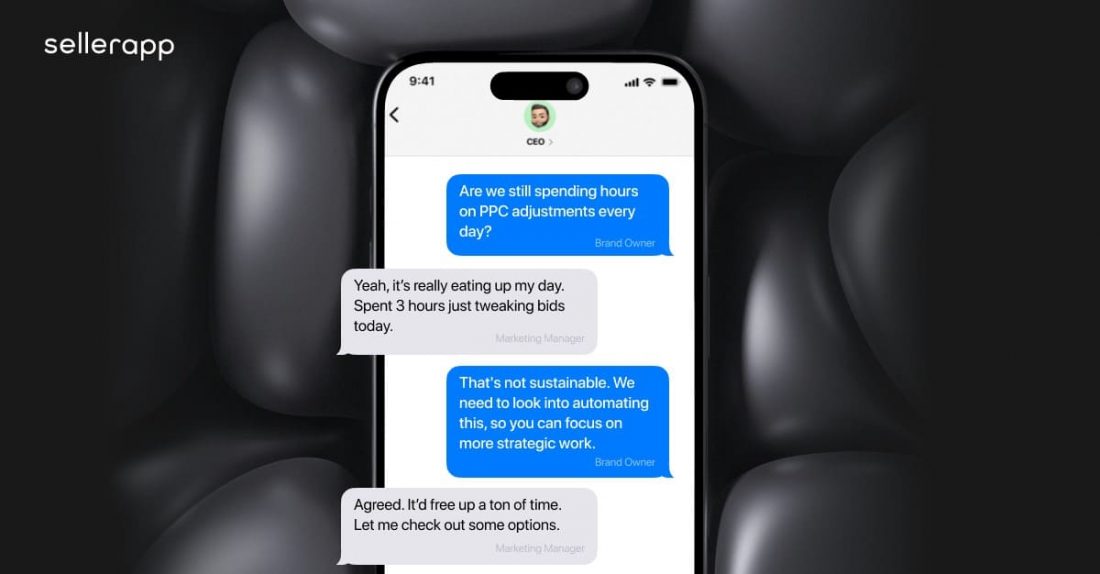
Saving time is an understatement when it comes to Automation. There is a massive difference between an Amazon business that takes advantage of Automation and one that does not.
A brand that uses an Amazon PPC optimization tool can achieve its goals significantly faster as it can save hours and days of manual effort.
Moreover, the overall process of executing campaigns becomes more efficient at the entire account level. Your pricing strategies are better, your reports are more insightful, and your ability to determine negative keywords is more effective, leading to a massive improvement in all your performance marketing strategies. This creates a positive feedback loop that skyrockets brand growth.
Most importantly, brands that use automation tools also tend to redirect their efforts to product research, inventory management, customer service, and other critical areas of their business.
Automation Tools are a Scalable Solution
The best part about using an automation tool is that it adapts and evolves with your business, leading to an effective and sustainable scale in your business. Automation tools also fuel the scalability of your campaigns. You can quickly adjust your campaigns based on product demand, inventory levels, or even based on the most effective keywords.
For example, automation tools can be incredibly powerful if you’re launching a new product and need to quickly scale your advertising campaigns. You can quickly set up custom rules to generate new keywords or efficiently increase visibility during a specific period when the audience is more likely to buy your product, etc.
This ability to rapidly adjust your PPC campaigns with less effort and with more flexibility without investing a significant amount of time or more resources leads to amazing scalability.
The Advantage of Additional Features
Almost all Amazon Automation Tools out there in the market will allow you to automate Amazon ads and your campaign management process. However, the extent to which you can optimize and derive insights varies immensely from tool to tool.
Most importantly, these automation tools have their proprietary technology and features. For example, certain Amazon PPC automation tools also come with rules-based automation and can set up various rules based on conditions or exclusions.
However, it can get relatively confusing without an intuitive dashboard or without rule templates to help you out initially.
Of course, Automation tools that can give you advanced features such as AI and reporting solutions or even projections of how much ad spend has been saved are the best in the market. Especially, as all the critical features that are necessary for you to succeed would already be refined and perfected.
Rule-based Automation vs AI Automation: What’s the difference?
Amazon is currently a blood bath and you will need to use an automation tool or your competitors who do will capture a larger portion of the market. Now, when choosing an automation tool, you may come across Rule-based or AI-based automation. We’ll quickly break down how both work and the benefits of each.
However, it’s extremely important to remember that when used together it becomes a power pair and is vastly more effective.
Rule-Based Automation
Rule-based automation offers a more strategic approach as compared to AI. You still have a bit of manual tasks. For example, setting up conditions and other information. Once these conditions and exclusions are set, the change will be triggered when these factors are met.
Of course, this is always going to be a lot less tedious than individual optimizing your PPC in Seller Central or the advertising console. If you’re a seasoned professional, this method will provide customization and control that you may find more attractive.
AI Automation
Unlike rule-based automation which requires your manual inputs and a strategy, AI automation takes advantage of machine learning algorithms to make decisions for you by holistically auditing your account or campaigns, and another large amount of data.
The AI makes changes in the bids and constantly keeps adapting to the results. Therefore, it ultimately keeps improving constantly. By getting the AI to do the heavy lifting and analyzing copious amounts of data that are extremely challenging for a human, you can effectively hand over the optimization of your Amazon Ads to AI. Or at least to a certain extent.
The table below helps you understand the major differences between AI-based and rule-based automation.
| Category | Rules-Based Automation | AI-Based Automation |
|---|---|---|
| Goal Setting | Possible | Possible |
| Advertiser Control | Provides more hands-on control and customization through user-defined rules. | Operates through algorithms, which can limit direct user control. |
| Decision-Making Capabilities | Operates on predefined conditions set by the user. Doesn't adjust quickly to changes unless rules are regularly updated. | Leverages machine learning algorithms for dynamic, data-driven decision-making. Continuously learns from historical data and adapts in real-time, fine-tuning targeting. |
| Adaptability | Rule-Based: Sticks to set rules and struggles to adapt as quickly to market shifts.Possibility of conflicting rules. | Swiftly adapts to changing market conditions. Optimizes campaigns using real-time and historical data for ongoing relevance. |
| Ease of Use/Complexity | Depending on the rules, it can be more or comparatively less efficient than AI. | Analyzes complex data, uncovering patterns and optimizing bids and ROI. Offers insights beyond typical human analysis. |
| Scalability | Can be limiting when there’s extensive data or requirements. However, this is not necessarily an absolute/ | Efficiently processes vast datasets for personalized optimizations. Can adapt to increasing business requirements. |
How to get started with automation?
It’s important to understand that every business will have its own unique goals and success metrics. Of course, there are also realistic metrics on the Amazon marketing side that you will need to consider.
Therefore, before you start automating your PPC campaigns simply to save time, there are several considerations to keep in mind:
Step 1: Set Clear Goals
Having clear goals to achieve is essential when it comes to advertising. Especially Amazon PPC as a high ACOS initially doesn’t mean that you’re brand isn’t growing. It’s important to note the more specific you are with your automation, the more of an impact you will have in terms of brand growth.
Essentially, the fluctuation in results and metrics will depend on your goals. Therefore, it is critical to establish what you hope to achieve. Setting a realistic, clear goal can also help you effectively formulate a plan and essentially drive your business forward.
Here are some common goals that are set by sellers: Increasing visibility, boosting organic ranking, growing market share, generating brand awareness, liquidating the inventory, and much more.
Step 2: Plan of Action
Once you’ve decided on the goal, you will want to decide how you can effectively achieve these goals. You need to be as specific as possible.
Will you achieve it via a combination of Amazon ppc automatic campaign and manual campaigns? Will you use a combination of both AI automation and rule-based automation? What are the specific rules you plan on running and will these rules conflict with each other?
Step 3: Set Up the Campaign
This would be the most important step. Create a campaign with a specific ad budget and make sure you are aware of all the metrics you want to monitor.
Then once you launch the campaign, it’ll be easier to use automation to optimize it until you achieve your goals. Also when you have a set of metrics as your north star, then you’ll know what’s working and not working at the overall campaign level.
Step 4: Setting up the Automation (Using SellerApp – The best Amazon PPC Automation and Optimisation Software)
When it comes to campaign optimization, you have three effective options with SellerApp: AI-based automation, Rules-based automation, or consulting with an Expert Opinion. This flexibility allows you to choose the approach that best meets your needs.
To automate Amazon ads and your PPC campaigns effectively, follow these steps:
1) Log in to the SellerApp Dashboard
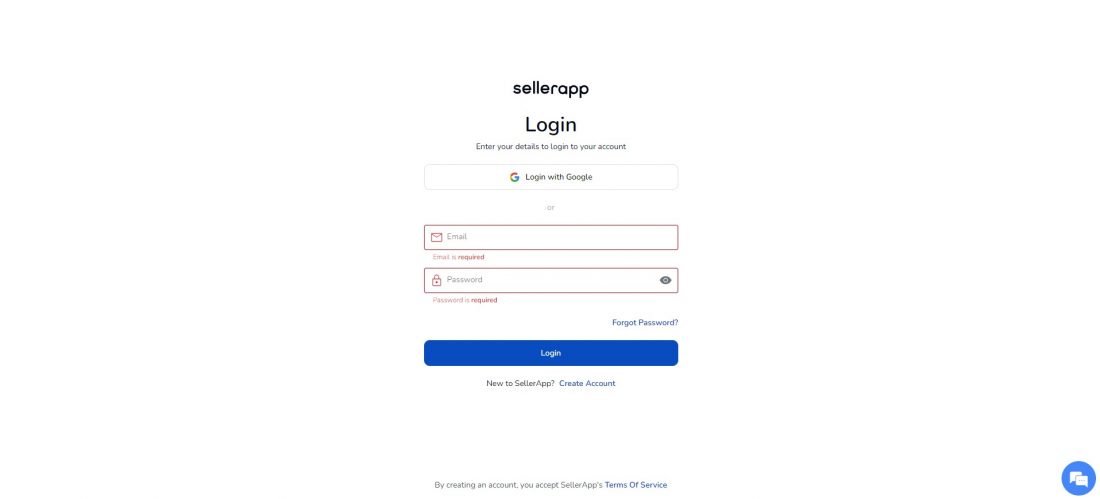
2) Navigate to Advertising
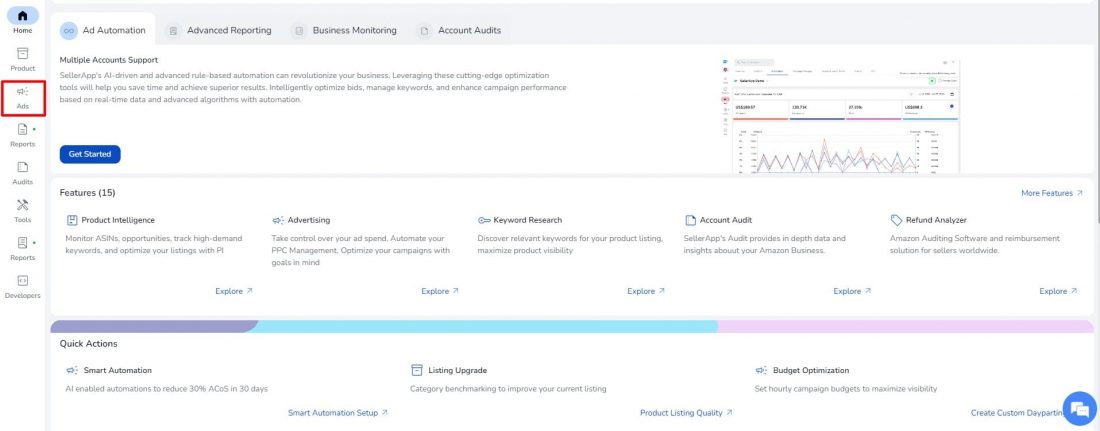
3) Click on Automation

4) Select Automation Type
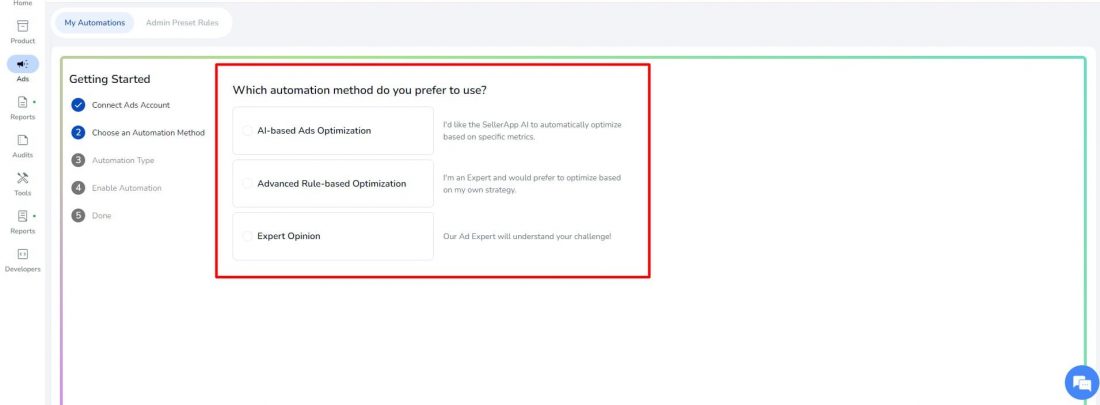
Under the My Automation tab, choose one of the following methods:
AI-based Ads Optimization
SellerApp’s AI can effectively automate Amazon ads, optimize your campaigns based on specific metrics, and do much more. This method leverages advanced algorithms to ensure your ads reach the right audience effectively.
Key features include:
Smart Bidding automatically adjusts bids to maximize impact, thereby enhancing visibility and driving organic sales. Coupled with Audience Targeting, which segments and targets the most relevant audience, these features significantly improve engagement and conversions, bringing a whole new dimension to the words “automate Amazon ads”.
Additionally, the automation capabilities help boost ROI while cutting costs, optimizing performance by minimizing expenses, and reducing wasted ad spend. The integration of Automated Bidding and Budget Optimization streamlines campaign management, allowing for a more efficient allocation of resources.
Once you choose AI-based automation, the next step is to determine how you want to automate Amazon ads. You can select from the following automation goals.
- Monthly Ad Budget
- ACoS Improvement
- ROAS
Advanced Rule-based Optimization
If you prefer a more hands-on approach, you can take advantage of advanced rule-based optimization, giving you greater control over your campaigns. This option allows you to create custom rules tailored to your strategy.
You can select the Create from Blank option to establish new rules based on multiple conditions, ensuring your campaigns operate as desired.
With this method, you can name your rule, choose between Amazon ppc automatic campaign and manual targeting options, and set specific conditions. There are several conditions to choose from, including:
- Bid
- Impressions
- Clicks
- Orders
- Spend
- Sales
- ACoS
- RoAS
- Click Through Rate (CTR)
- Conversion Rate (CVR)
- CPC (Cost Per Click)
You can add more conditions and specify the actions to take when those conditions are met, such as increasing or decreasing bids or pausing campaigns.
Additionally, you can opt for advanced keyword and ASIN target options and define exclusions for search terms associated with that rule.
Or You Can Always Use SellerApp’s Rule Templates
We can appreciate that it all may be a bit overwhelming if you’re new to rule-based automation. Therefore, we introduced several rule templates based on recurring seller objectives to help you effectively automate Amazon ads and get started. These rule templates tend to be extremely effective when used correctly.
Here are some templates you can choose from:
ROI Maximizer: 2.7X RoAS by enhancing bids for high-performing targets yielding a significant number of orders.
Keyword Picker: 1.4X Clicks by driving engagement through identifying and creating new keywords from profitable search terms.
Target Harvester: 2.9X Impressions by boosting visibility through creating new targets from associated search terms with high impression share.
Wasted Click Eliminator: 30% Spend reduction by negating search terms with low conversions while maintaining visibility for brand search terms.
ACoS Reducer: 40% Reduction in ACoS by creating negative targets to remove underperforming search terms.
Down Bid Optimizer: 0.8X ACoS through bid reductions on non-performing keywords/ASINs.
Dayparting Rule: 70% reduction in wasted clicks by optimizing budget allocation based on hours with low conversions.
Search Rank Booster: 1.75X Organic Growth by adjusting bids for keywords that have gained or lost organic position on Amazon.
Inventory Refactoring: 95% chance of avoiding stockouts by optimizing ad visibility when inventory levels drop.
After automation is set up, it’s essential to:
- Consistently test your campaigns. Although automating Amazon advertising reduces your workload, it’s advisable to review your campaigns regularly, such as weekly or bi-weekly.
- Monitor campaign performance by tracking metrics thoroughly to effectively automate Amazon advertising, then adjust your strategy based on insights gained.
Fundamentally, for any automation to be effective, you need to ensure the basics are right. This foundational knowledge helps you manage ad campaigns effectively and achieve desired results within a reasonable budget.
SellerApp is a data-driven platform tailored for brands on Amazon, having optimized ad spend worth over $1B globally, ensuring you’re running efficient PPC campaigns from the start.
5) Complete Setup.
If you encounter any challenges during the process, our Amazon PPC experts are always ready to help!
Selecting an Automation Partner
It’s important to note that using an automation tool is not as simple as signing up to the first tool you find on Google. You will need to assess your advertising operations, understand your brand goals, identify the different opportunities for automation, and much more.
After all, if you’re a new seller and do not have enough Ad Spend or your revenue is super low, then you may not benefit from automation. However, this is fundamentally a case-by-case decision. Therefore, it’s best to get an Amazon expert to conduct an audit.
Moreover, you also need to recognize that you won’t be just using a tool but selecting a growth partner. Ideally, the company you partner with will also need to have a good support team to help guide you through the product and more. For example, SellerApp has a killer team of Amazon experts who have scaled 7 figure Amazon businesses to 8 figures.
So, if you’re in a rut, you can always take advantage of our Managed Services (an Amazon PPC automation service) which uses the perfect combination of an Amazon expert and SellerApp’s proprietary automation tools and data to effectively automate Amazon advertising for you.
Of course, from a tech perspective, it would be ideal if the automation tool can integrate seamlessly with your existing tech stack or at the very least is good enough to meet your specific needs.
Final Thoughts
Ultimately, Amazon PPC Automation enables you to focus on strategy innovation (product development) and frees up time to help you explore new channels. You can also take advantage of this brilliant tool to optimize and drastically limit any waste in ad spend.
Automation can result in amazing campaign management and even foster a seamless ecosystem where data, creativity and execution intersect.
Automation is, especially, important for larger brands that manage thousands of campaigns or are looking to expand their market share on other platforms.
Of course, Amazon PPC agencies or similar Amazon ppc automation services also benefit significantly from automating labor intensive tasks such as campaign management, budget allocation, performance optimizations and reporting. By automating Amazon ads, they can drastically reduce manual effort, maximize efficiency and much more.
Finally, even when it comes to the question of what is better for you: AI-basee automation or Rule-based automation, it’s important to understand that this will totally depend on your ad expertise and goals. However, from experience we’ve noticed that a hybrid approach tends to work the best. Sign up to SellerApp and get started today.
Related Posts:
Amazon Attribution For Better Conversions.


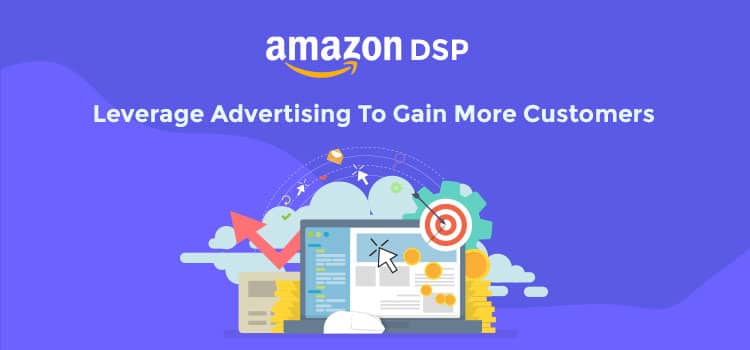
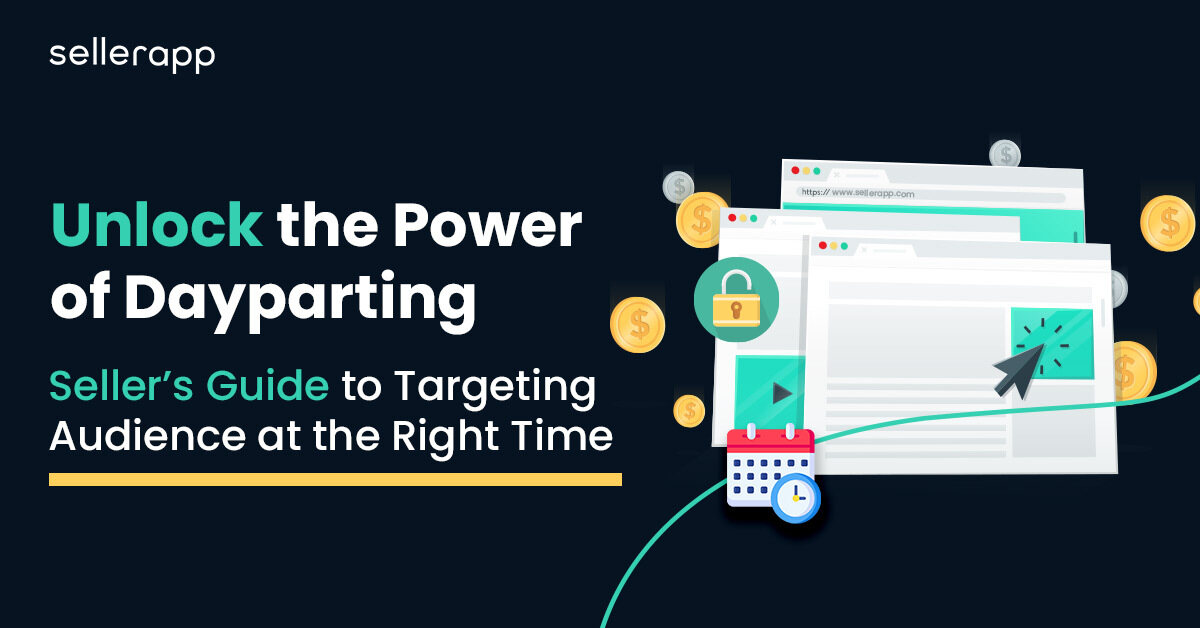

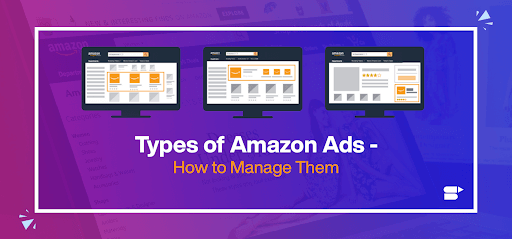
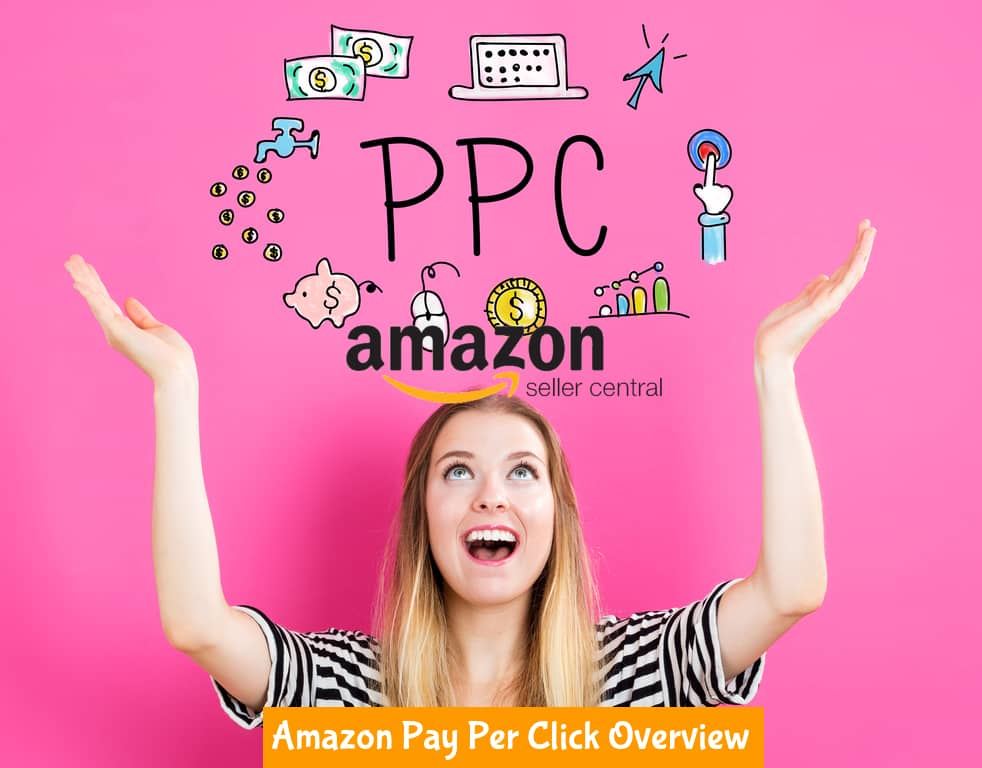

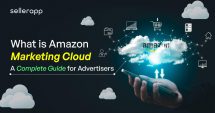
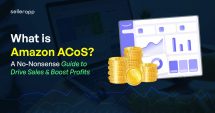
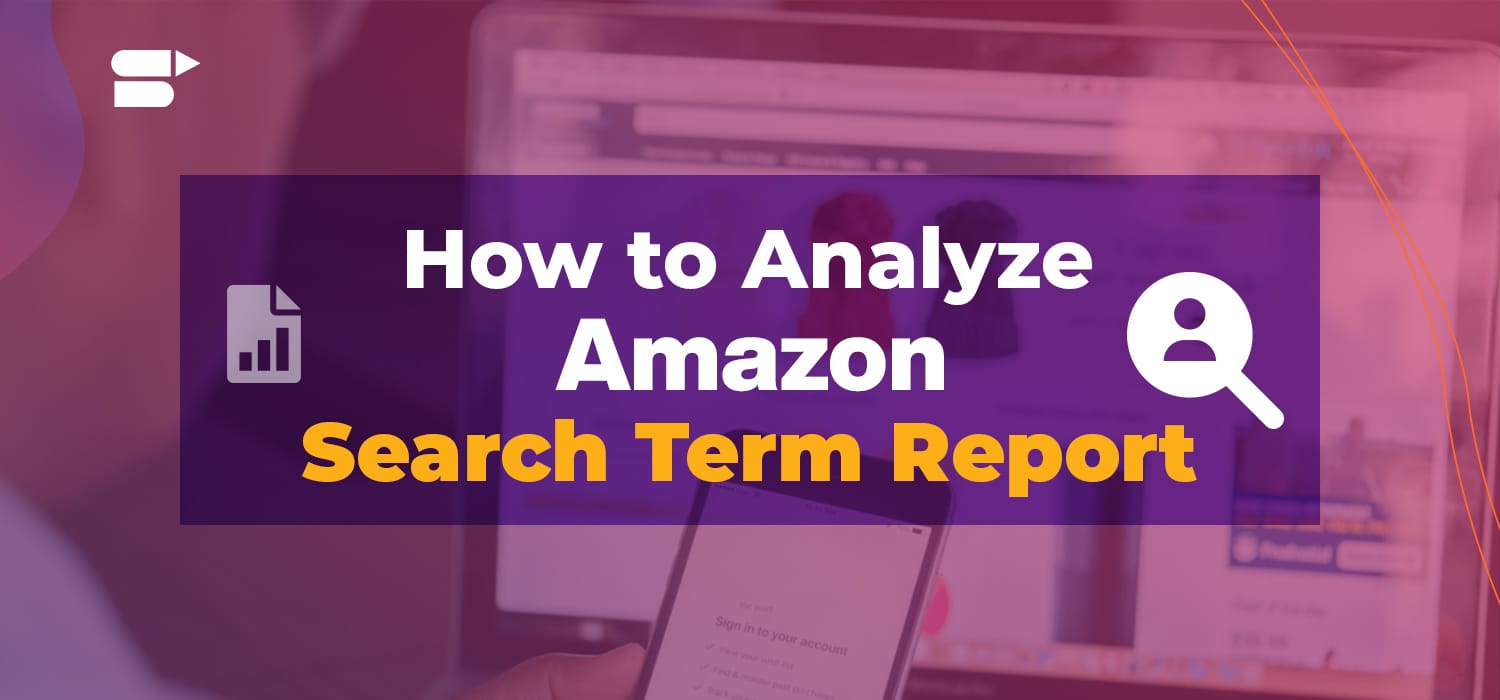
Gabriel Kernen
March 25, 2021Great post
Mulhollen
April 20, 2021I am happy to seek out numerous useful information right here in the post, we need develop more techniques in this regard, thank you for sharing team
William
July 5, 2021Really enjoyed this blog post, Thank you for sharing.
Arishekar N
May 27, 2022Glad you liked the article.
Walter
November 25, 2021Valuable Information. Thanks SellerApp
Arishekar N
May 27, 2022Thank you for reading.
Miraj
November 30, 2021Wonderful post for Amazon PPC Automation for Business.
Arishekar N
May 27, 2022Thanks for reading.